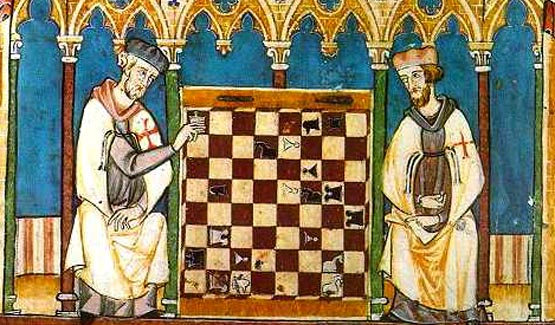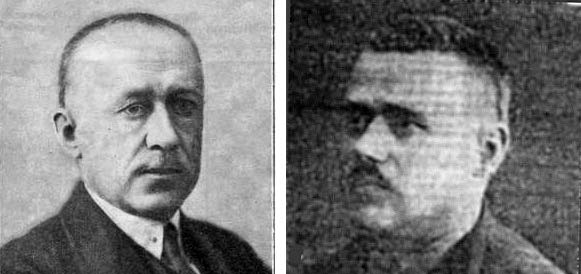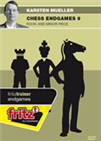Brothers in harms
Prior to this article, I must amend a small but important thing about the early riddles, the “mansuba” or “mansubes”. According to some sources, they with their accompanying stories were also used for bets, to challenge solvers, meaning that the authors of such works or those with their knowledge were able to earn a small favor on the side — or have to give one if he found good solvers. This, however, was not done in an organized way, such as solving championships, but rather as we today would imagine bets in pubs, small tests of skill that might have earned them the equivalent of a drink or two, but likely not of a living. However, the caliphs might have favored good storytellers...
 Although I have no siblings, I know the relationship between brothers is a peculiar one, filled either by love or hate. In the Bible we read about many brothers betraying each other, starting with the story of Cain and Abel. It is unclear if Cain intended to kill Abel, and much unlikely by what we read in the Bible — after all, no death had happened before and the thought that something like death exists would most likely not have crossed Cain’s mind. Of course, Adam and Eve, when Cain had left Eden, had more children, starting with Seth. If we believe in this story, at some point all but two humans were siblings, and naturally incest occured until it was forbidden by the creator many centuries later. We can only assume — or try to evaluate by findings of humans — how different the pre-incestuous humans must have been from the modern homo sapiens sapiens.
Although I have no siblings, I know the relationship between brothers is a peculiar one, filled either by love or hate. In the Bible we read about many brothers betraying each other, starting with the story of Cain and Abel. It is unclear if Cain intended to kill Abel, and much unlikely by what we read in the Bible — after all, no death had happened before and the thought that something like death exists would most likely not have crossed Cain’s mind. Of course, Adam and Eve, when Cain had left Eden, had more children, starting with Seth. If we believe in this story, at some point all but two humans were siblings, and naturally incest occured until it was forbidden by the creator many centuries later. We can only assume — or try to evaluate by findings of humans — how different the pre-incestuous humans must have been from the modern homo sapiens sapiens.
Brothers who worked together have shown a lot of powerful and enjoyable works. In Germany, the Grimm brothers are very famous for their lifelong quest to collect fairy tales told throughout the — then much bigger — German Empire. As much as the tale of standing on the shoulders of giants would go from our last episode, they were collecting the dwarves, the fairy tales, to show them to the world. Much of the German cultural fairy tales heritage, taught still today to children — but regrettably too few — comes from their collection, with tales such as “Hänsel und Grethel” being recognized throughout many countries.
The Wright brothers proved the possibility of air travel for everyone, in their tireless work on a flying machine. They must have been thought of as madman, but the success of their venture proved them right.
Today we look not at the Kubbel brothers — those will be subject of a later article — but an early pair of chess composition brothers known as Vasily and Michail Nikolaevich Platov from Riga. Vasily (24.iii.1881-17.vi.1952) was the older, Michail (5.vi.1883 — August or September 1938?) the younger brother.

Vasily and Mikhail Platov | Photos: Arves.org
Vasily Platov had graduated in medicine. Mikhail was an engineer, leading a “kolchos” (a form of collective farm) in Serpukhov. Unfortunately Mikhail Platov criticised the policies of Stalin’s government, leading to a sentence of ten years in a work camp. He died there sometime after August 22nd, 1938, in Kargopol at the age of 55, most likely in August or September. Vasily, on the other hand, if he criticised the government, was not caught. He had several chess columns in Russian newspapers and died of natural causes in 1952, aged 71.
Although Troitzky (see our January article) was still active at the time, the Platov brothers are generally recognized as his successors in the development of endgame studies.
For linguistically interested readers, we reached out to Rainer Staudte to learn the meaning of the names of composers. One of his friends provided several interpretations, which we reproduce here, although she interpreted “Trotzky” instead of “Troitzky”.
For Platov, the word “plat” is short for “Platon”, meaning “broad” or “with broad shoulders”. It also can mean a “horse blanket”. The surname comes likely from Ataman, a cossack leader.
Korolkov stems from “korol” for “king”. It could mean a person that wants to reign but is made fun of, a “koroljok”. It also is a bird. Another interpretation is from corals, predecessors of gems. Finally it could mean someone from the village of Korolki.
For Trotzky (not Troitzky, although the meanings might be similar) it is from the German word “Trotz” (most likely in the medieval meaning of resisting against something). Less likely from “Troiza” with the ending “tzky” stemming from Ukrainian, Belarussian or Polish. This however could be likely for Troitzky, in my opinion. Regional interpretations would be from the town of Trakai (Troki) in Poland, or from Troksy district in Belarus.
As Staudte remarks, every name could have multiple meanings, so for me they are unable to tell about the family history, unlike German names which often amount to different spellings of medieval occupations such as “Schmid” (smith), “Maier” (farmer/rancher), “Müller” (miller), “Becker” (baker) etc.
Still it is a bit of a dream that “Platov” indeed could stem from the Greek philosopher “Platon”. Distant relatives? We will never know.
What we will know is that the five compositions selected this time are worth replaying, the comments of your author are found as usual next to the notation in the replay box.
 Endings with rook and minor piece against rook and minor piece occur very frequently, even more often than rook endings, yet there's not much literature on them. This endgame DVD fills this gap. The four different material constellations rook and knight vs rook and knight, rooks and opposite coloured (and same coloured ) bishops and rook and bishop vs rook and knight are dealt with. In view of the different material constellations Karsten Mueller explains many guidelines like e.g. "With knights even a small initiative weighs heavily".
Endings with rook and minor piece against rook and minor piece occur very frequently, even more often than rook endings, yet there's not much literature on them. This endgame DVD fills this gap. The four different material constellations rook and knight vs rook and knight, rooks and opposite coloured (and same coloured ) bishops and rook and bishop vs rook and knight are dealt with. In view of the different material constellations Karsten Mueller explains many guidelines like e.g. "With knights even a small initiative weighs heavily".There are two studies that somehow in my brain always look very similar to me even although they are very different, one is by the Platov brothers. When I was young, my teacher Siegfried S. or Alexander W. gave it to me to solve but I don’t remember which one. You will find both diagrams below, possibly you want to give them a shot? The solutions are shown afterwards.
Rules of thumb are the key to everything when you are having to set the correct course in a complex endgame. In this final DVD of his series on the endgame, our endgame specialist introduces you to the most important of these rules of thumb.
Solutions
 Friedrich Amelung (23.iii.1842 - 22.iii.1909) died two days (in the Julian calendar) prior to his 77th birthday, the Gregorian calendar given here gives one day as difference only. Amelung came from an industrial family, he was born in Katharina, today in Estonia. I remember a school class in Germany having a project about glass facilities in Katharina belonging to Amelung’s family, but their great research is only available in German and possibly not at all on the internet anymore. As we read instad in Wikipedia, his grandfather Carl Philipp Amelung was founder of the Spiegel-Glas-Fabrik unter Woizek. Amelung himself became a chess publisher, mainly of the Baltische Schachblätter from 1889 onward in however only eight issues over longer periods. It is no doubt also because of this tireless energy that he founded in 1898 the Baltic Chess Federation, dissolved at the end of the at its time so-called “War to end all wars”, World War One. It still is regarded as predecessor of the chess federations of the new both countries Estonia and Latvia. The future of the latter country, regarding chess composition, is in the hands of Julia Vysotska whom I have met twice, a very pleasant experience each time as her energy for chess seems neverending, although we only briefly conversed, her assuring me she works to gain young people; according to her website this includes solving competitions. So can she be called a spiritual successor to Amelung? Hardly, as they are too different in their work, but not less important than the other.
Friedrich Amelung (23.iii.1842 - 22.iii.1909) died two days (in the Julian calendar) prior to his 77th birthday, the Gregorian calendar given here gives one day as difference only. Amelung came from an industrial family, he was born in Katharina, today in Estonia. I remember a school class in Germany having a project about glass facilities in Katharina belonging to Amelung’s family, but their great research is only available in German and possibly not at all on the internet anymore. As we read instad in Wikipedia, his grandfather Carl Philipp Amelung was founder of the Spiegel-Glas-Fabrik unter Woizek. Amelung himself became a chess publisher, mainly of the Baltische Schachblätter from 1889 onward in however only eight issues over longer periods. It is no doubt also because of this tireless energy that he founded in 1898 the Baltic Chess Federation, dissolved at the end of the at its time so-called “War to end all wars”, World War One. It still is regarded as predecessor of the chess federations of the new both countries Estonia and Latvia. The future of the latter country, regarding chess composition, is in the hands of Julia Vysotska whom I have met twice, a very pleasant experience each time as her energy for chess seems neverending, although we only briefly conversed, her assuring me she works to gain young people; according to her website this includes solving competitions. So can she be called a spiritual successor to Amelung? Hardly, as they are too different in their work, but not less important than the other.

Carl Behting (27.x.1867-28.iii.1943) was one of the organizers of the chess life in Riga, and influential for the opening theory of the Latvian gambit, marked by the moves 1.e4 e5 2.Sf3 f5. While the opening certainly is interesting, it requires great knowledge of theory and likely does not give any advantage, so we see it rarely on a high level. Boris Spassky and Ivan Sokolov wear it in their repertoire, according again to German Wikipedia.
Behting’s most famous study known as “Kc6!! study” was proven to be sound several times by various chess composers, including multiple solving world champion John Nunn with computer assistance in his 2012 article about it:
John Nunn: 'The Behting study is sound'
Looking forward
The next issue of this article series will up the ante again: After one Troitzky and two Platovs we will look at three Kubbels. However, this won’t continue on: There aren’t four main protagonists planned for April...
You probably know that you can move pieces on our replay boards to analyse, and even start an engine to help you. You can maximize the replayer, auto-play, flip the board and even change the piece style in the bar below the board.
At the bottom of the notation window on the right there are buttons for editing (delete, promote, cut lines, unannotate, undo, redo) save, play out the position against Fritz and even embed the ChessBase game viewer on your web site or blog. Hovering the mouse over any button will show you its function.

World Federation for Chess Composition (www.wfcc.ch)
Links


















 Although I have no siblings, I know the relationship between brothers is a peculiar one, filled either by love or hate. In the Bible we read about many brothers betraying each other, starting with the story of Cain and Abel. It is unclear if Cain intended to kill Abel, and much unlikely by what we read in the Bible — after all, no death had happened before and the thought that something like death exists would most likely not have crossed Cain’s mind. Of course, Adam and Eve, when Cain had left Eden, had more children, starting with Seth. If we believe in this story, at some point all but two humans were siblings, and naturally incest occured until it was forbidden by the creator many centuries later. We can only assume — or try to evaluate by findings of humans — how different the pre-incestuous humans must have been from the modern homo sapiens sapiens.
Although I have no siblings, I know the relationship between brothers is a peculiar one, filled either by love or hate. In the Bible we read about many brothers betraying each other, starting with the story of Cain and Abel. It is unclear if Cain intended to kill Abel, and much unlikely by what we read in the Bible — after all, no death had happened before and the thought that something like death exists would most likely not have crossed Cain’s mind. Of course, Adam and Eve, when Cain had left Eden, had more children, starting with Seth. If we believe in this story, at some point all but two humans were siblings, and naturally incest occured until it was forbidden by the creator many centuries later. We can only assume — or try to evaluate by findings of humans — how different the pre-incestuous humans must have been from the modern homo sapiens sapiens.
 Friedrich Amelung (23.iii.1842 - 22.iii.1909) died two days (in the Julian calendar) prior to his 77th birthday, the Gregorian calendar given here gives one day as difference only. Amelung came from an industrial family, he was born in Katharina, today in Estonia. I remember a school class in Germany having a project about glass facilities in Katharina belonging to Amelung’s family, but their great research is only available in German and possibly not at all on the internet anymore. As we read instad in Wikipedia, his grandfather Carl Philipp Amelung was founder of the Spiegel-Glas-Fabrik unter Woizek. Amelung himself became a chess publisher, mainly of the Baltische Schachblätter from 1889 onward in however only eight issues over longer periods. It is no doubt also because of this tireless energy that he founded in 1898 the Baltic Chess Federation, dissolved at the end of the at its time so-called “War to end all wars”, World War One. It still is regarded as predecessor of the chess federations of the new both countries Estonia and Latvia. The future of the latter country, regarding chess composition, is in the hands of Julia Vysotska whom I have met twice, a very pleasant experience each time as her energy for chess seems neverending, although we only briefly conversed, her assuring me she works to gain young people; according to her website this includes solving competitions. So can she be called a spiritual successor to Amelung? Hardly, as they are too different in their work, but not less important than the other.
Friedrich Amelung (23.iii.1842 - 22.iii.1909) died two days (in the Julian calendar) prior to his 77th birthday, the Gregorian calendar given here gives one day as difference only. Amelung came from an industrial family, he was born in Katharina, today in Estonia. I remember a school class in Germany having a project about glass facilities in Katharina belonging to Amelung’s family, but their great research is only available in German and possibly not at all on the internet anymore. As we read instad in Wikipedia, his grandfather Carl Philipp Amelung was founder of the Spiegel-Glas-Fabrik unter Woizek. Amelung himself became a chess publisher, mainly of the Baltische Schachblätter from 1889 onward in however only eight issues over longer periods. It is no doubt also because of this tireless energy that he founded in 1898 the Baltic Chess Federation, dissolved at the end of the at its time so-called “War to end all wars”, World War One. It still is regarded as predecessor of the chess federations of the new both countries Estonia and Latvia. The future of the latter country, regarding chess composition, is in the hands of Julia Vysotska whom I have met twice, a very pleasant experience each time as her energy for chess seems neverending, although we only briefly conversed, her assuring me she works to gain young people; according to her website this includes solving competitions. So can she be called a spiritual successor to Amelung? Hardly, as they are too different in their work, but not less important than the other.






